For botanical soap making, keep oils and lye solutions between 120-130°F for ideal saponification. Add delicate botanicals like chamomile and calendula around 100°F, while hardier herbs can withstand higher temperatures. Essential oils should be incorporated between 100-130°F to prevent evaporation. Use a digital thermometer for precision and adjust your temperatures seasonally—cooler in summer (100-110°F) and warmer in winter. Our thorough temperature chart will transform your garden-to-bar soaping experience.
Botanical Soap Temperature Chart: From Garden to Bar
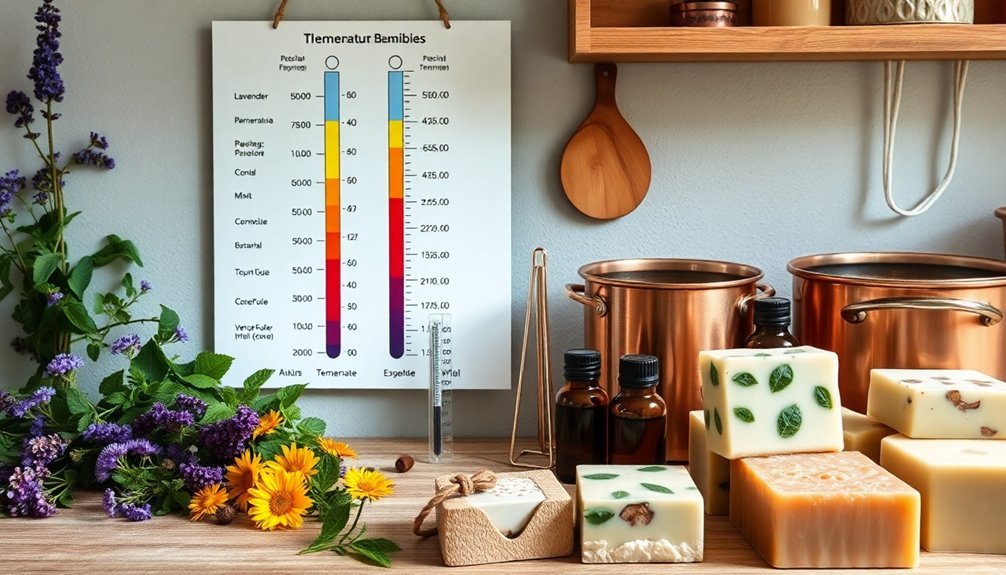
When creating botanical soaps from garden ingredients, understanding temperature control becomes your most critical skill for success. The ideal temperature range for both soap making oils and lye solution is 120-130°F, ensuring proper saponification process while preventing false trace.
You'll need careful temperature management when working with fresh botanicals, as some contain sugars that can raise temperatures unexpectedly. Reference your temperature chart when incorporating different botanical ingredients to avoid overheating delicate additives like milk or herbs, which can scorch and ruin your soap's scent and texture.
Consider insulating your molds to enhance the gel phase, which brings out vibrant colors in your botanical soaps. This controlled heat during curing transforms your garden harvests into stunning bars with that coveted translucent sheen professionals achieve.
Understanding Temperature Zones for Botanical Soaps
Different botanical soap-making methods require specific temperature considerations to preserve plant properties.
You'll need to adjust between hot process (131-160°F) and cold process (120-130°F) depending on temperature-sensitive materials like milk, tea, or beeswax.
Infusing botanicals at their ideal temperature points—cooler for delicate ingredients, warmer for hardier additions—ensures your soap maintains both aesthetic appeal and therapeutic benefits.
Hot Process Versus Cold
Although both methods create beautiful handmade soaps, hot and cold processes demand distinctly different temperature management approaches for botanical soap making.
In cold process soap making, you'll need to maintain oils and lye solution within a specific temperature range (120-130°F) to guarantee proper saponification. This careful temperature management preserves the integrity of delicate botanical additives while allowing you to control whether your soap enters the gel phase through insulation.
Hot process soap, conversely, leverages additional heat to accelerate saponification. You won't need to cool your lye solution, making the process quicker but potentially affecting heat-sensitive botanicals. The soap naturally reaches gel phase during cooking, enhancing color vibrancy.
Each method influences your botanical soaps' final texture, appearance, and scent differently, so select your approach based on your specific ingredients and desired outcomes.
Temperature-Sensitive Plant Materials
Botanical ingredients bring unique colors, textures, and properties to your handmade soaps, but they're remarkably temperature-sensitive.
When introducing herbs, flowers, or essential oils to your soap batter, timing and temperature management are essential for preserving their beneficial qualities.
For best results, add your botanical ingredients when your soap reaches 120-130°F. This temperature range maintains their integrity while ensuring proper incorporation into the saponification process.
Consider cooling lye solutions beforehand to prevent essential oil evaporation and herb discoloration.
Don't overlook the gel phase—this higher temperature stage can enhance your botanicals' visual appeal. However, you'll need to balance insulation carefully to avoid damaging delicate plant materials.
Remember that different botanicals have unique temperature tolerances. Some thrive in cooler environments while others require warmth to release their full potential in your soap.
Optimal Botanical Infusion Points
Successful botanical soap making relies on understanding key temperature zones that create perfect infusion points throughout the process. The ideal infusion temperatures for most botanical ingredients fall between 120-130°F, where you'll achieve maximum extraction without compromising their beneficial properties.
For delicate botanicals like chamomile and calendula, lower your temperatures to around 100°F to preserve their gentle qualities.
Remember that high infusion temperatures above 140°F can cause essential oils to evaporate, diminishing both scent and therapeutic benefits in your final product.
When steeping herbs or flowers, maintain warm temperatures for 1-2 hours to fully extract their qualities.
Carefully monitoring the temperature throughout the infusion process prevents scorching while ensuring you're capturing all the botanical goodness your plants have to offer.
Critical Temperature Points for Common Garden Additives
When incorporating garden-fresh additives into your soap creations, you'll need to monitor temperature carefully to maintain their beneficial properties. Different botanical additives require specific soaping temperature ranges to preserve their fragrance properties and contribute to your soap's texture.
| Additive Type | Ideal Temp (°F) | Benefits |
|---|---|---|
| Herbs/Flowers | 120-130 | Preserves integrity and color |
| Fruit Juices | 100-110 | Prevents scorching, smooths texture |
| Essential Oils | 110-120 | Maintains aromatic properties |
| Natural Colorants | 120 | Maximizes color vibrancy |
| Glycerin Infusions | 115-125 | Prevents rivers, guarantees even distribution |
Heat-Sensitive Herbs: Optimal Working Temperatures
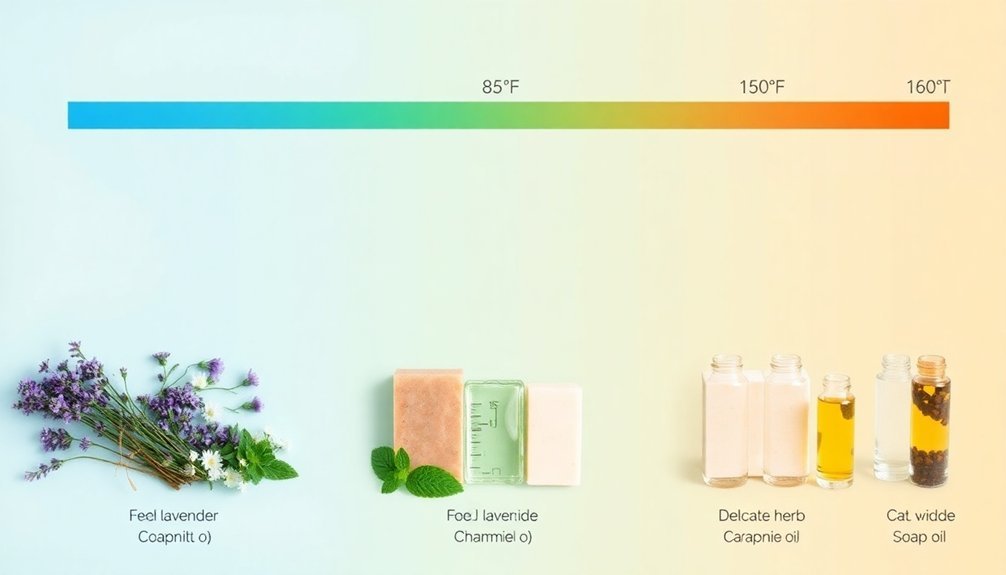
Heat-sensitive herbs demand special attention in your soap-making journey. For best results, incorporate chamomile and calendula at cooler temperatures (100-110°F) to preserve their therapeutic qualities.
When working with essential oils derived from these delicate botanicals, remember they can lose potency when exposed to heat above 120°F.
To protect these precious ingredients, infuse your oils with herbs at lower temperatures before adding them to your soap mixtures. Herbs like lavender and peppermint should be added after reaching trace, preventing their volatile compounds from evaporating.
Careful temperature control throughout your process guarantees your finished bars maintain their intended benefits and appearance.
Cold Process Temperature Management With Floral Infusions
You'll need to maintain your floral-infused oils between 120-130°F to guarantee proper saponification without compromising their botanical properties.
To prevent extract discoloration, cool your lye solution before combining it with your infusions and add delicate floral components at trace rather than during the initial mixing.
When working with temperature-sensitive botanicals, employ gradual cooling techniques such as water baths or ambient cooling rather than refrigeration, which can cause unwanted texture issues in your finished soap.
Floral Oil Temperature Ranges
Though many soapmakers prioritize fragrance and aesthetics, proper temperature management remains essential when working with floral infusions in cold process soap.
Your floral oils perform best when incorporated at 120-130°F, matching the ideal soaping temperature for optimal saponification.
When preparing your lye solution, cool it to the same temperature range before combining with your floral-infused oils. This prevents rapid saponification that could diminish the delicate properties of your botanicals.
Always check that your oils appear clear and fully melted to avoid false trace issues.
Maintaining temperature consistency throughout your process protects the integrity of floral components, preserving their scent and visual appeal.
Proper temperature control also prevents common soap defects like soda ash and glycerin rivers, ensuring your botanical creations remain vibrant and beautiful.
Preventing Extract Discoloration
Floral extracts require precise temperature management to prevent discoloration in your cold process soap. Maintain a soaping temperature between 120-130°F to preserve the vibrant colors and delicate scents of your floral infusions.
Before combining with oils, cool your lye solution thoroughly—hot lye causes botanical extracts to darken and lose their natural hues.
For ideal color retention, add your floral infusions at trace rather than during initial mixing. This minimizes heat exposure and protects their integrity.
Working at cooler temperatures (100-110°F) helps avoid gel phase, which often triggers discoloration in botanically-infused soaps.
When you're finished, consider light insulation for your soap molds—just enough to guarantee even saponification without excessive heat build-up.
This balanced approach prevents the thermal damage that causes extract discoloration while still allowing proper curing.
Ideal Cooling Techniques
Managing the cooling process effectively creates the foundation for successfully incorporating floral infusions into cold process soap. When your lye solution reaches temperatures above the ideal 120-130°F range, employ cooling techniques such as placing the container in a water bath.
You'll need to monitor temperature carefully as you bring both oils and lye solution to similar temperatures before combining.
Room temperature floral infusions can naturally help lower your soap mixture's overall heat. After pouring into your soap mold, consider insulation to promote gel phase, which enhances color vibrancy and improves the integration of botanical additives while preventing soda ash formation.
Remember that maintaining proper temperature control throughout the process prevents overheating issues like alien brain formations and guarantees complete saponification.
Your careful temperature management will result in perfectly textured botanical soap bars.
Hot Process Modifications for Delicate Plant Materials
While high temperatures are essential for the saponification process, they can quickly degrade the beneficial properties of delicate plant materials. You'll need to adjust your technique to preserve their integrity.
Always add botanical ingredients after the initial saponification phase when temperatures have dropped below 160°F.
For floral additives like rose petals or lavender buds, consider infusing oils with these materials beforehand. This technique captures their aromatic qualities without subjecting them to harsh heat.
When using plants as natural colorants, add them at trace or just before pouring to minimize color degradation.
As you monitor saponification, be vigilant for signs of overheating. Too much heat can transform vibrant botanicals into brown specks.
Temperature Effects on Essential Oil Performance
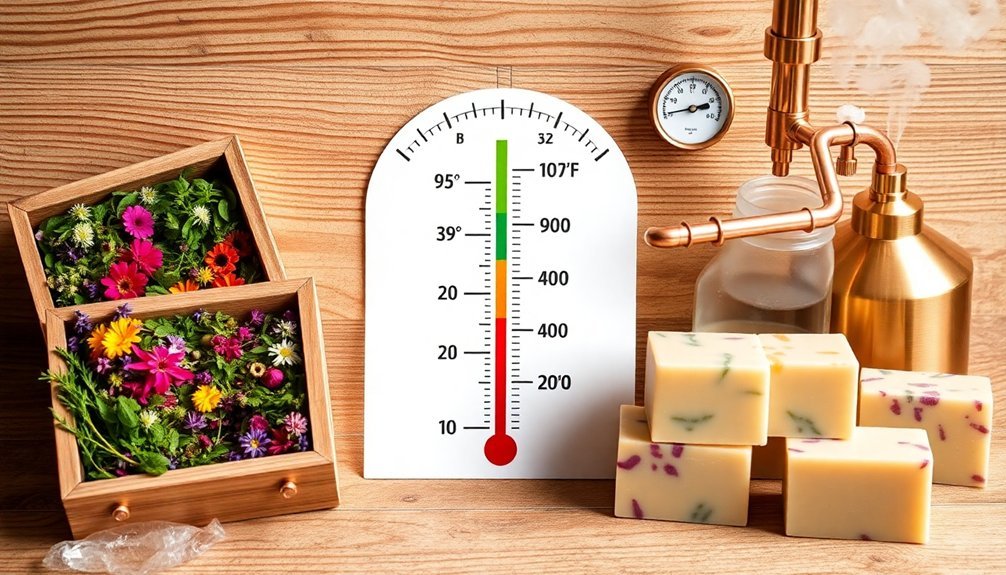
Essential oils represent the heart and soul of botanical soaps, yet their delicate chemical structures demand precise temperature management.
You'll achieve the best results by incorporating them within the ideal temperature range of 100-130°F, which preserves their fragrance and therapeutic properties.
When your soap base exceeds 160°F, volatile compounds evaporate rapidly, diminishing both scent and beneficial qualities. Conversely, adding oils at too-cool temperatures reduces scent throw and prevents even distribution throughout your soap.
Be particularly cautious with citrus oils, which can accelerate saponification at higher temperatures, potentially causing your batch to seize.
Remember that ambient temperatures affect your soap batter's viscosity, directly impacting how well essential oils disperse.
Preserving Natural Colorants Through Temperature Control
Natural colorants in botanical soaps require precise temperature management to maintain their vibrant appearance and integrity. The saponification process generates heat that can cause color degradation if not carefully controlled. You'll find that working between 120-130°F provides ideal conditions for most botanicals, while heat-sensitive extracts benefit from cooler soaping temperatures around 100-110°F.
| Colorant | Ideal Temp | Gel Phase | Notes |
|---|---|---|---|
| Spirulina | 100-110°F | Avoid | Fades quickly when overheated |
| Turmeric | 120-130°F | Beneficial | Enhanced by controlled gel phase |
| Beetroot | 105-115°F | Partial | Maintain cooler temperatures to preserve pink hues |
| Annatto | 120-125°F | Beneficial | Colors deepen during gentle gel phase |
| Indigo | 110-120°F | Optional | Stable but benefits from temperature consistency |
Add colorants at trace when your soap batter is cooler to preserve color intensity and prevent unwanted reactions from excessive heat.
Seasonal Temperature Adjustments for Garden-to-Bar Soaping
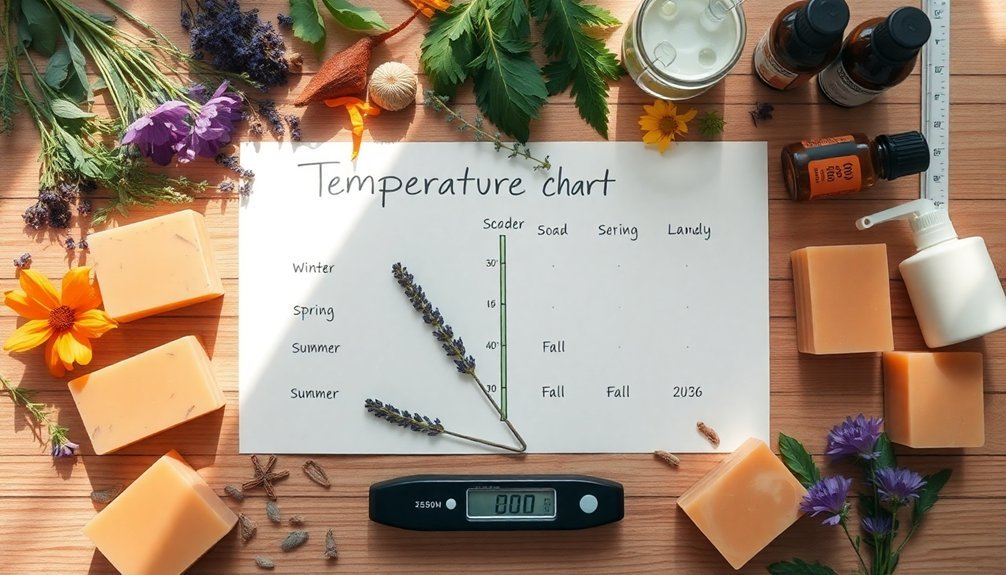
As seasons shift throughout the year, you'll need to adapt your soaping techniques to accommodate changing ambient temperatures that affect your garden-to-bar process.
Maintaining ideal soap temperatures between 120-130°F guarantees proper saponification regardless of weather conditions.
- Summer Strategy: Use cooler lye temperatures (100-110°F) when working with temperature-sensitive botanical ingredients to prevent overheating and control the gel phase.
- Winter Approach: Fully melt all oils at recommended temperatures to avoid false trace that occurs when fats solidify in colder environments.
- Insulating Techniques: Add blankets or heating pads during winter months while reducing insulation during summer to prevent soap volcanoes.
- Monitoring Method: Regularly check room temperature and adjust both lye and oil temperatures accordingly to maintain quality texture, color, and trace in your botanical soaps.
Master Temperature Chart for 25 Common Botanical Additives
Now that you understand how to adjust for seasonal temperature variations, let's examine specific temperature requirements for common botanical additives you'll use in your soaps.
Most botanical additives perform well at standard soaping temperatures of 120-130°F, ensuring proper saponification while preserving their beneficial properties.
However, delicate ingredients like rose petals require cooler processing (100-110°F) to prevent discoloration. Hardier additives such as lavender and chamomile can withstand higher temperatures and even benefit from the gel phase (up to 180°F) for enhanced color vibrancy.
When incorporating ingredients like honey or fruit purees, diligent monitoring temperature becomes essential as these can generate internal heat.
For best results, always research the specific temperature tolerances of each botanical addition—this knowledge will help you achieve consistent, beautiful soaps while maintaining the integrity of your garden-sourced ingredients.
Troubleshooting Temperature-Related Botanical Discoloration
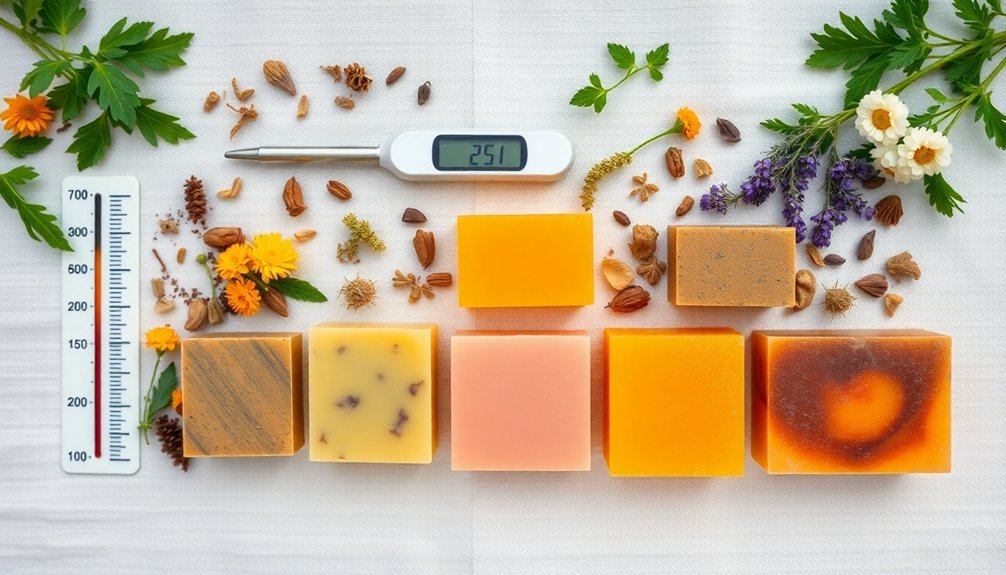
Temperature control is your first line of defense against botanical discoloration, with herbs requiring 110-120°F to maintain their integrity while floral ingredients perform best at 100-115°F.
You'll need to monitor your soap throughout the curing process, as even properly prepared botanicals can shift colors if temperatures spike unexpectedly.
For problematic ingredients like calendula or chamomile, try infusing them in your oils 24 hours before soapmaking rather than adding them directly to your batch.
Preventing Herb Discoloration
While creating botanical soaps with vibrant natural colors might seem straightforward, many crafters struggle with herbs that mysteriously turn brown during the soap-making process.
To maintain those beautiful green and colorful botanicals, you'll need to carefully manage temperature throughout your soap-making journey.
- Maintain a soaping temperature between 120-130°F to guarantee proper saponification without triggering the chemical reaction that browns herbs.
- Use dried herbs instead of fresh ones, as they're less susceptible to discoloration in cold process soap.
- Consider whether to prevent gel phase or carefully insulate your soap—gel phase can enhance colors but excessive heat leads to botanical darkening.
- Try incorporating herbs at trace rather than earlier in the process to minimize their exposure to heat and lye.
Floral Preservation Temperatures
Floral additives present a particular challenge in temperature management, as these delicate ingredients are especially prone to discoloration when exposed to improper heat levels.
To maintain their vibrant colors during saponification, keep your soap mixture between 120-130°F. Temperatures exceeding 160°F will cause browning or scorching of your botanical ingredients, compromising both appearance and fragrance.
Add your floral elements after reaching trace but before pouring into molds, ensuring the mixture remains within the ideal temperature range.
When using temperature-sensitive additives like milk, keep your lye solution cool (around 100°F) to prevent overheating.
During the gel phase, proper insulation helps maintain consistent temperatures that preserve floral colors. However, be cautious with excessive insulation, as it can raise temperatures beyond the safe threshold, resulting in discoloration of your carefully selected botanicals.
Equipment Recommendations for Precise Temperature Monitoring
Successful botanical soap making depends heavily on your temperature monitoring equipment, as even small variations can greatly affect the final product's quality.
For precise temperature management throughout your soap making process, invest in these essential tools:
- Accurate digital thermometer – Guarantees your lye and oils stay within the critical 120-130°F range for ideal saponification.
- Infrared thermometers – Provide quick, contactless surface readings of your soap mixture, allowing for immediate adjustments.
- Kitchen scale – Weighs ingredients precisely, helping you maintain proper temperature ratios between oils and lye.
- Thermo-insulated containers – Maintain consistent temperatures of your ingredients, preventing unwanted temperature fluctuations.
Your stick blender serves a dual purpose – not only mixing ingredients thoroughly but also distributing heat evenly throughout your soap batter, contributing to more uniform curing.
Frequently Asked Questions
What Is the Temperature Range for Soap Making?
You'll want to keep your soap making temperatures between 120-130°F for ideal saponification. You can also work cooler (100-110°F) to prevent gel phase or hotter (131-160°F) to enhance colors and reduce soda ash.
What Temperature Should Soap Be Poured At?
You'll want to pour your cold process soap when both oils and lye solution reach 120-130°F. Keep them within 10° of each other for proper saponification. For milk-based recipes, aim slightly cooler at 100-110°F.
What Is the Optimum Temperature for Saponification?
You'll achieve ideal saponification when both your lye solution and oils are between 120-130°F. Keep them within 10 degrees of each other to guarantee effective chemical reactions and prevent issues like false trace.
What Happens if You Use Cold Process Soap Too Soon?
If you use cold process soap too soon, you'll encounter skin irritation, crumbly texture, and poor lather. The soap won't have properly cured, leaving potentially harsh lye and lacking its intended fragrance and quality.
In Summary
You've now mastered the critical temperatures needed to preserve your garden's botanical properties in soap. By following this chart, you'll avoid discoloration and maintain the therapeutic benefits of your herbs and flowers. Remember, precision matters—invest in quality monitoring equipment and adjust for seasonal variations. Your botanical soaps will transform from simple bars to powerful plant-based creations that honor nature's chemistry from garden to bar.

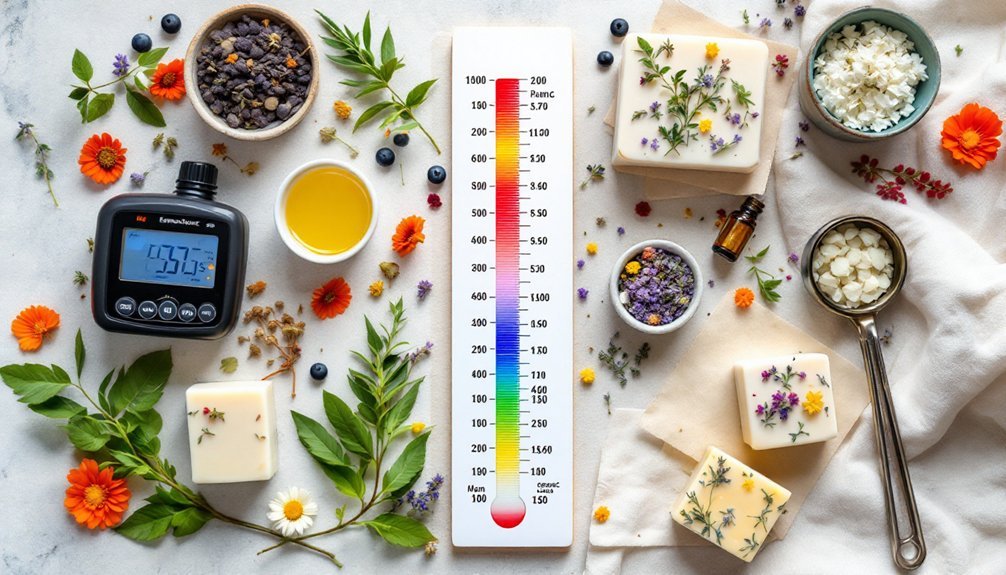



Leave a Reply